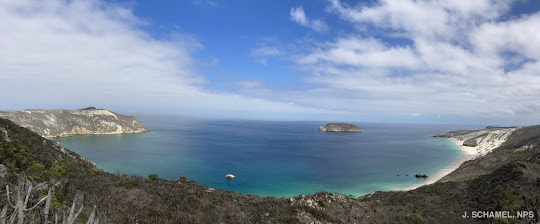Friends of the Island Fox educators had a great question from a student in the Oak Park School District in California.
Are the foxes on the San Juan Islands in Washington island foxes?
 |
| Monascherie for San Juan Visitors Bureau |
San Juan Island in Washington does in deed have a fox population; it's the only island along the coast of Washington that does.
The foxes range in color from tawny red to silvery black, but if you know your foxes there is a distinct characteristic that tells you these foxes are very different from the Channel Island fox. The tail tip is white!
How to ID North American Foxes
The foxes on San Juan Island are red foxes (Vulpes vulpes).
The story of the San Juan Island foxes has some similar plot points to island foxes:
- introduction of non-native species to an island
- damage to an island ecosystem
- a search for ecosystem balance
In the 1800s, a lighthouse was built on San Juan Island to help ships avoid dangerous waters. (Just like the lighthouse on Anacapa Island). Transporting fresh food to the island was costly, so in the late 1800s, European rabbits were introduced to San Juan Island to provide a fresh meat source for lighthouse keepers.
Without any natural predators on the island, the rabbits quickly began devouring the native island plants. The island ecosystem was crashing. There were too many rabbits for the people to control. It's believed that some time around 1930, red foxes and/or red foxes bred to have black fur for the fur industry were introduced or set free on San Juan Island. It was hoped that the red foxes would control the rabbit population and also provide foxes for people to hunt.
The red fox population on San Juan Island is fairly small, but they have controlled the European rabbits and, fortunately, they have not had a negative impact on other native island species. The island has returned to a tenuous balance and the red foxes are now protected on San Juan Island.
The red foxes have been isolated on San Juan Island for almost 100 years.
Will they develop island adaptations? Will they become island dwarfs over time like the island fox? How long will it take for them to evolve into a new species? Only time and evolution can tell.
Island foxes on California's Channel Island remain the only island-endemic fox species in the United States.
If you have a good question about island foxes send FIF an email at info@islandfox.org.












